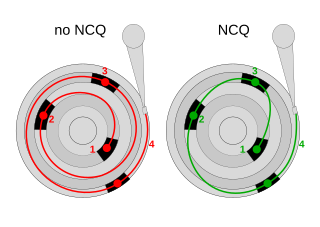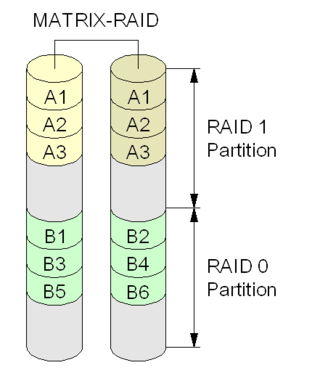Related Research Articles

Parallel ATA (PATA), originally AT Attachment, also known as IDE, is a standard interface designed for IBM PC-compatible computers. It was first developed by Western Digital and Compaq in 1986 for compatible hard drives and CD or DVD drives. The connection is used for storage devices such as hard disk drives, floppy disk drives, and optical disc drives in computers.

SATA is a computer bus interface that connects host bus adapters to mass storage devices such as hard disk drives, optical drives, and solid-state drives. Serial ATA succeeded the earlier Parallel ATA (PATA) standard to become the predominant interface for storage devices.
A disk array controller is a device that manages the physical disk drives and presents them to the computer as logical units. It almost always implements hardware RAID, thus it is sometimes referred to as RAID controller. It also often provides additional disk cache.

Multi-booting is the act of installing multiple operating systems on a single computer, and being able to choose which one to boot. The term dual-booting refers to the common configuration of specifically two operating systems. Multi-booting may require a custom boot loader.
A host controller interface (HCI) is a register-level interface that enables a host controller for USB or IEEE 1394 hardware to communicate with a host controller driver in software. The driver software is typically provided with an operating system of a personal computer, but may also be implemented by application-specific devices such as a microcontroller.

UEFI is a set of specifications written by the UEFI Forum. They define the architecture of the platform firmware used for booting and its interface for interaction with the operating system. Examples of firmware that implement these specifications are AMI Aptio, Phoenix SecureCore Tiano, TianoCore EDK II and InsydeH2O.

In computing, Native Command Queuing (NCQ) is an extension of the Serial ATA protocol allowing hard disk drives to internally optimize the order in which received read and write commands are executed. This can reduce the amount of unnecessary drive head movement, resulting in increased performance for workloads where multiple simultaneous read/write requests are outstanding, most often occurring in server-type applications.

The USB mass storage device class is a set of computing communications protocols, specifically a USB Device Class, defined by the USB Implementers Forum that makes a USB device accessible to a host computing device and enables file transfers between the host and the USB device. To a host, the USB device acts as an external hard drive; the protocol set interfaces with a number of storage devices.

QEMU is a free and open-source emulator. It emulates the machine's processor through dynamic binary translation and provides a set of different hardware and device models for the machine, enabling it to run a variety of guest operating systems. It can interoperate with Kernel-based Virtual Machine (KVM) to run virtual machines at near-native speed. QEMU can also do emulation for user-level processes, allowing applications compiled for one architecture to run on another.

Advanced Configuration and Power Interface (ACPI) is an open standard that operating systems can use to discover and configure computer hardware components, to perform power management, auto configuration, and status monitoring. First released in December 1996, ACPI aims to replace Advanced Power Management (APM), the MultiProcessor Specification, and the Plug and Play BIOS (PnP) Specification. ACPI brings power management under the control of the operating system, as opposed to the previous BIOS-centric system that relied on platform-specific firmware to determine power management and configuration policies. The specification is central to the Operating System-directed configuration and Power Management (OSPM) system. ACPI defines hardware abstraction interfaces between the device's firmware, the computer hardware components, and the operating systems.

The EFIsystem partition or ESP is a partition on a data storage device that is used by computers having the Unified Extensible Firmware Interface (UEFI). When a computer is booted, UEFI firmware loads files stored on the ESP to start installing operating systems and various utilities.

Oracle VM VirtualBox is a type-2 hypervisor for x86 virtualization developed by Oracle Corporation. VirtualBox was originally created by InnoTek Systemberatung GmbH, which was acquired by Sun Microsystems in 2008, which was in turn acquired by Oracle in 2010.
I/O Controller Hub (ICH) is a family of Intel southbridge microchips used to manage data communications between a CPU and a motherboard, specifically Intel chipsets based on the Intel Hub Architecture. It is designed to be paired with a second support chip known as a northbridge. As with any other southbridge, the ICH is used to connect and control peripheral devices.

Intel Rapid Storage Technology (RST) is a driver SATA AHCI and a firmware-based RAID solution built into a wide range of Intel chipsets. Currently also is installed as a driver for Intel Optane temporary storage units.
A trim command allows an operating system to inform a solid-state drive (SSD) which blocks of data are no longer considered to be 'in use' and therefore can be erased internally.

USB Attached SCSI (UAS) or USB Attached SCSI Protocol (UASP) is a computer protocol used to move data to and from USB storage devices such as hard drives (HDDs), solid-state drives (SSDs), and thumb drives. UAS depends on the USB protocol, and uses the standard SCSI command set. Use of UAS generally provides faster transfers compared to the older USB Mass Storage Bulk-Only Transport (BOT) drivers.
The Intel X79 is a Platform Controller Hub (PCH) designed and manufactured by Intel for their LGA 2011 and LGA 2011-1.
NVM Express (NVMe) or Non-Volatile Memory Host Controller Interface Specification (NVMHCIS) is an open, logical-device interface specification for accessing a computer's non-volatile storage media usually attached via PCI Express (PCIe) bus. The initialism NVM stands for non-volatile memory, which is often NAND flash memory that comes in several physical form factors, including solid-state drives (SSDs), PCIe add-in cards, and M.2 cards, the successor to mSATA cards. NVM Express, as a logical-device interface, has been designed to capitalize on the low latency and internal parallelism of solid-state storage devices.
Aggressive Link Power Management (ALPM) is a power management protocol for Advanced Host Controller Interface-compliant (AHCI) Serial ATA (SATA) devices, such as hard disk drives and solid-state drives.

SATA Express is a computer bus interface that supports both Serial ATA (SATA) and PCI Express (PCIe) storage devices, initially standardized in the SATA 3.2 specification. The SATA Express connector used on the host side is backward compatible with the standard SATA data connector, while it also provides two PCI Express lanes as a pure PCI Express connection to the storage device.
References
- 1 2 "Serial ATA AHCI: Specification, Rev. 1.3.1". Intel Corp. Retrieved 2015-05-03.
- ↑ "NVMe vs. SATA: Which SSD Technology Is Faster?". www.howtogeek.com. Retrieved 2020-10-10.
- 1 2 "Intel Matrix Storage Technology - Changing and/or choosing Serial ATA Modes". Intel. Retrieved 2007-09-30.
- ↑ "PCI IDE Controller Specification 1.0" (PDF). Berg Software Design. Retrieved 2015-05-03.
- ↑ "Ahci(4)".
- ↑ "ArcaOS Changelog" . Retrieved 2020-08-24.
- ↑ "What's New in the Solaris 10 8/07 Release - Driver Enhancements". Oracle. Archived from the original on 2007-10-25. Retrieved 2010-10-20.
- ↑ "Error Message when you start a Windows 7 or Windows Vista-based computer after you change the SATA mode of the boot drive: "STOP 0x0000007B INACCESSABLE_BOOT_DEVICE"". Microsoft. Archived from the original on 24 May 2011. Retrieved 2011-04-20.
- ↑ "Enabling AHCI mode AFTER Windows 10 installation". tenforums.com user Toobad. Retrieved 2015-12-19.
- ↑ "StorAHCI replaces MSAHCI (Windows)". Microsoft.
- ↑ "Improving performance of SATA drives on Windows 2012".
- ↑ "Support | How to enable AHCI support after install". Novell.com. Retrieved 2014-05-11.